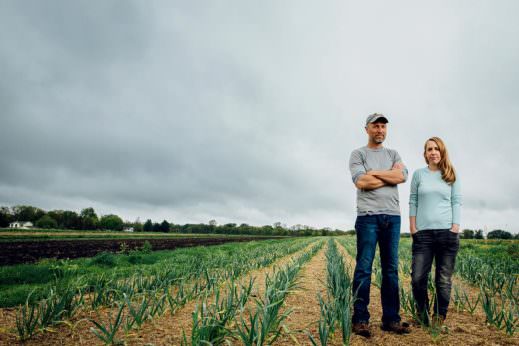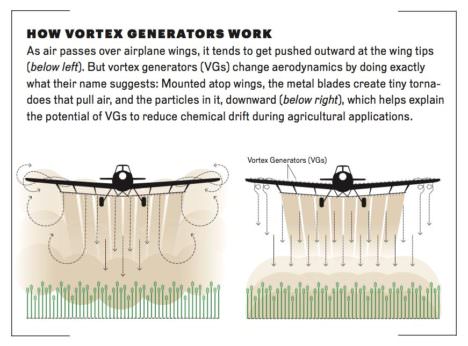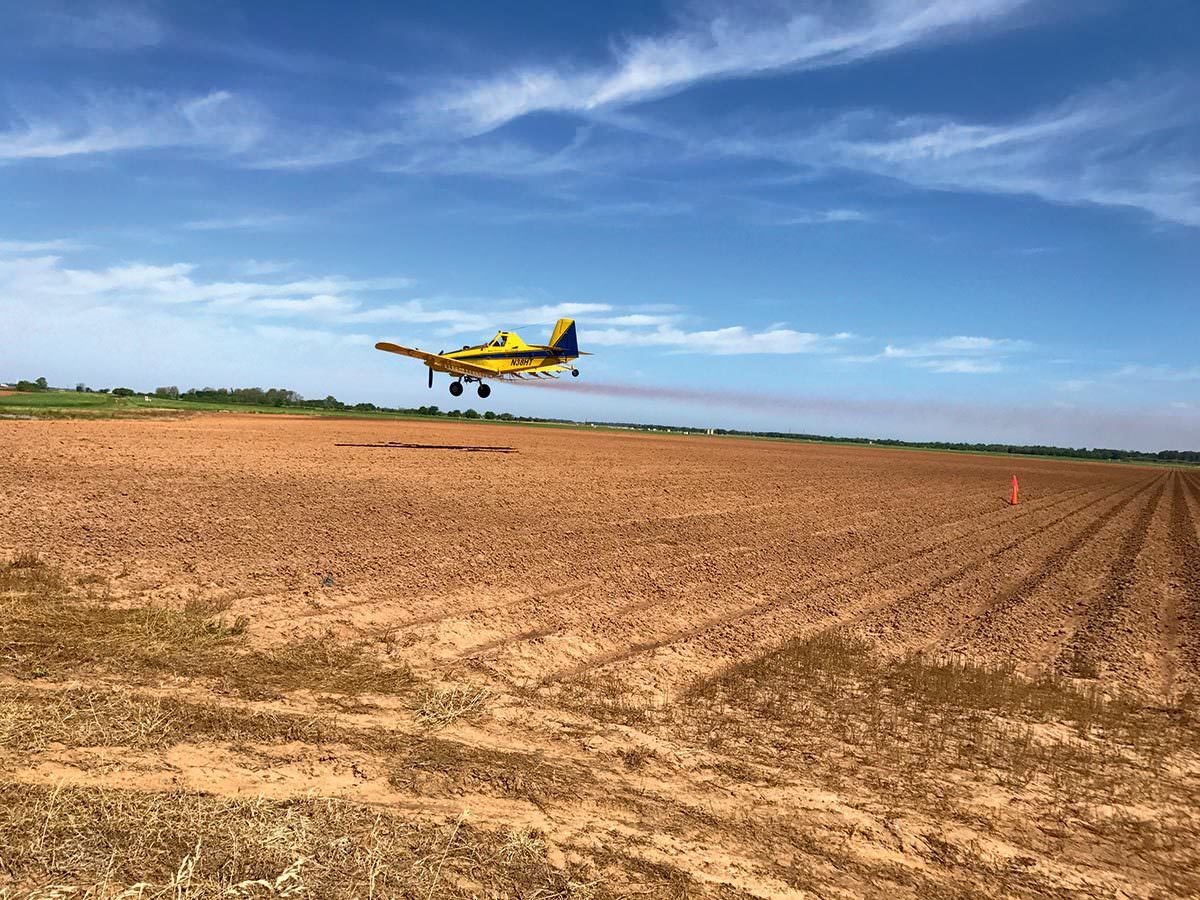The Perils of Pesticide Drift
Chemical spraying misses its mark with alarming frequency, and neighboring farms – especially organic ones – often pay the price.
“It’s like riding down the highway and expecting to keep the exhaust from your car within the boundaries of the road.”
ANDREW AND MELISSA DUNHAM spent years transforming their farm, which has been in his family for five generations, from a conventional producer of corn, soy, and alfalfa into a diversified operation with 40 different kinds of fruits and vegetables, a herd of 20 grass-fed cattle, even a few beehives. Finally, in May 2009, the couple’s 80 acres in Grinnell, Iowa – now named Grinnell Heritage Farm – became certified organic.
Just two months later, the Dunhams’ pickers spotted a crop duster flying low over nearby seed-corn fields, then noticed a cloud creeping toward them. The crew got out of the way as a fog of fungicide descended on two acres of hay, effectively revoking the acreage’s organic certification for three years, the chemical-free transition period required by the USDA.
The Dunhams’ farm regained full certification in 2012, and the following year, trouble was in the air again. “I could smell it,” says Andrew. “A metallic smell, like a railroad tie.” On the back of a 15-mph wind, a plume of insecticide from a spraying rig began wafting onto the Dunhams’ asparagus. Andrew jumped in his car and rushed to the neighbors’ farm. “To their credit, they stopped spraying,” he says. But the damage had been done: The tainted acre cost the Dunhams tens of thousands of dollars during the three years the produce couldn’t be sold at premium organic prices.

Grinnell Heritage Farm is an island of sustainable agriculture in a sea of commodity crops. Iowa leads the nation in corn and soy production, with 13.8 million acres of corn and 9.5 million acres of soybeans that together generated $14.6 billion in revenue last year. The state is also a hotbed of chemical application. Most of its farm acreage is sprayed with herbicide twice a season. Roundup Ready seed remains the norm, but many producers don’t stop at glyphosate; they also apply other powerful weed killers, such as atrazine, and insecticides, including neonicotinoids.
The Dunhams attempted to mitigate their risk by posting “No Spraying” signs and installing a 30-foot-deep perimeter of buffer shrubs; both methods obviously proved inadequate. “Applications usually result in some deposition away from the targeted site,” accord- ing to an Environmental Protection Agency spokesperson.
Though neither the EPA nor various state agencies could provide reliable statistics on the total number of drift incidents, experts agree that reported cases represent the mere tip of the iceberg. “We don’t have a good count due to underreporting,” explains Linda Wells, the Midwest director of organizing for the nonprofit Pesticide Action Network. “Many people neglect to report or do not know who to report to.” In Iowa, it’s the state department of agriculture’s pesticide bureau, which offers no online information about reporting drift. Mark Hanna, an extension agricultural engineer with Iowa State University, says, “The state receives around 200 drift complaints per year, but it’s difficult to grasp the magnitude of the problem.”

Minimizing it, however, may be possible. Drones can hover close and spray with great precision, and electrostatic spraying uses an electric charge to attract pesticide droplets to target plants. Both technologies are still years away from widespread implementation, but a potential quick fix has emerged out of the USDA’s Aerial Application Technology Research Unit (AATRU) in College Station, Texas. Large-scale farms like the ones surrounding the Dunhams’ typically opt for aerial application over ground-rig spraying, because planes cover huge swaths faster, decreasing the time workers must be sidelined (per EPA regulations that prohibit them from reentering treated areas for up to 72 hours).
Starting in 2013, Daniel Martin, a research engineer at the AATRU, and his colleagues conducted a study to determine how small wing-mounted blades called vortex generators (VGs) – intended to increase pilot control of commercial and military airplanes – might affect the way agricultural aircraft spray chemicals. Martin’s team outfitted planes with VGs and used dye in place of pesticides. In one test, the VGs reduced the amount of drift by 40 to 45 percent.
Martin, 50, hypothesizes that the tiny vortexes created by VGs help pull pesticide spray down below the plane, thus preventing it from getting caught in the airflow coming off the wings, which can cause the droplets to drift off target (see “How Vortex Generators Work,” below left). He continues to test the concept, and hopes that aerial applicators will retrofit their planes with VGs (at a cost of only about $2,000 per plane).

David Eby, a veteran aerial applicator in Wakarusa, Indiana, believes that pesticide drift will persist as long as wind and human error remain factors. “It’s like riding down the highway and expecting to keep the exhaust from your car within the boundaries of the road,” he explains. Nevertheless, the 68-year-old is intrigued by the prospect of VGs. “Reducing drift is a win for everybody,” says Eby, whose firm received only one such com- plaint after spraying 375,000 acres in 2016. Already, he employs a digital service called FieldWatch, which allows farmers with vulnerable crops and livestock to register their properties online, alerting aerial applicators to sensitive zones.
Though the Dunhams listed Grinnell Heritage Farm on FieldWatch earlier this year, they’re not overly optimistic. The couple managed to recoup some of their drift-related losses after settling with the applicators’ insurance carriers – but only after producing years’ worth of records and receipts. “It was an all- consuming task,” Andrew explains. “I’d rather have been in the fields.”
SaveSave
Follow us

This work is licensed under a Creative Commons Attribution-NoDerivatives 4.0 International License.
Want to republish a Modern Farmer story?
We are happy for Modern Farmer stories to be shared, and encourage you to republish our articles for your audience. When doing so, we ask that you follow these guidelines:
Please credit us and our writers
For the author byline, please use “Author Name, Modern Farmer.” At the top of our stories, if on the web, please include this text and link: “This story was originally published by Modern Farmer.”
Please make sure to include a link back to either our home page or the article URL.
At the bottom of the story, please include the following text:
“Modern Farmer is a nonprofit initiative dedicated to raising awareness and catalyzing action at the intersection of food, agriculture, and society. Read more at <link>Modern Farmer</link>.”
Use our widget
We’d like to be able to track our stories, so we ask that if you republish our content, you do so using our widget (located on the left hand side of the article). The HTML code has a built-in tracker that tells us the data and domain where the story was published, as well as view counts.
Check the image requirements
It’s your responsibility to confirm you're licensed to republish images in our articles. Some images, such as those from commercial providers, don't allow their images to be republished without permission or payment. Copyright terms are generally listed in the image caption and attribution. You are welcome to omit our images or substitute with your own. Charts and interactive graphics follow the same rules.
Don’t change too much. Or, ask us first.
Articles must be republished in their entirety. It’s okay to change references to time (“today” to “yesterday”) or location (“Iowa City, IA” to “here”). But please keep everything else the same.
If you feel strongly that a more material edit needs to be made, get in touch with us at [email protected]. We’re happy to discuss it with the original author, but we must have prior approval for changes before publication.
Special cases
Extracts. You may run the first few lines or paragraphs of the article and then say: “Read the full article at Modern Farmer” with a link back to the original article.
Quotes. You may quote authors provided you include a link back to the article URL.
Translations. These require writer approval. To inquire about translation of a Modern Farmer article, contact us at [email protected]
Signed consent / copyright release forms. These are not required, provided you are following these guidelines.
Print. Articles can be republished in print under these same rules, with the exception that you do not need to include the links.
Tag us
When sharing the story on social media, please tag us using the following: - Twitter (@ModFarm) - Facebook (@ModernFarmerMedia) - Instagram (@modfarm)
Use our content respectfully
Modern Farmer is a nonprofit and as such we share our content for free and in good faith in order to reach new audiences. Respectfully,
No selling ads against our stories. It’s okay to put our stories on pages with ads.
Don’t republish our material wholesale, or automatically; you need to select stories to be republished individually.
You have no rights to sell, license, syndicate, or otherwise represent yourself as the authorized owner of our material to any third parties. This means that you cannot actively publish or submit our work for syndication to third party platforms or apps like Apple News or Google News. We understand that publishers cannot fully control when certain third parties automatically summarize or crawl content from publishers’ own sites.
Keep in touch
We want to hear from you if you love Modern Farmer content, have a collaboration idea, or anything else to share. As a nonprofit outlet, we work in service of our community and are always open to comments, feedback, and ideas. Contact us at [email protected].by Sara Novak, Modern Farmer
August 18, 2017
Modern Farmer Weekly
Solutions Hub
Innovations, ideas and inspiration. Actionable solutions for a resilient food system.
ExploreExplore other topics
Share With Us
We want to hear from Modern Farmer readers who have thoughtful commentary, actionable solutions, or helpful ideas to share.
SubmitNecessary cookies are absolutely essential for the website to function properly. This category only includes cookies that ensures basic functionalities and security features of the website. These cookies do not store any personal information.
Any cookies that may not be particularly necessary for the website to function and are used specifically to collect user personal data via analytics, ads, other embedded contents are termed as non-necessary cookies.
